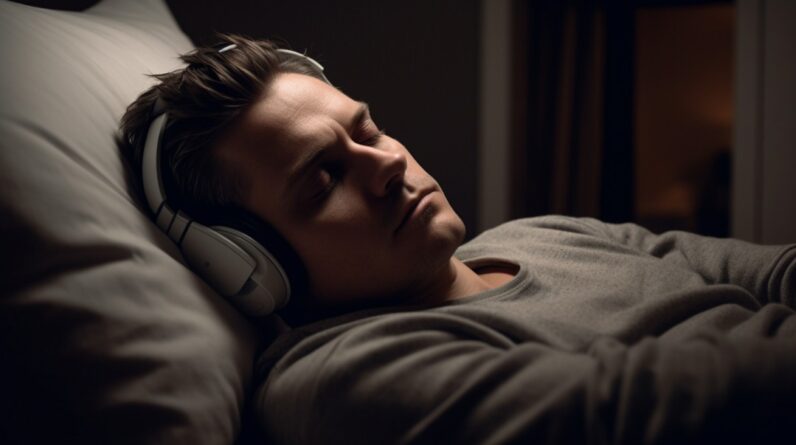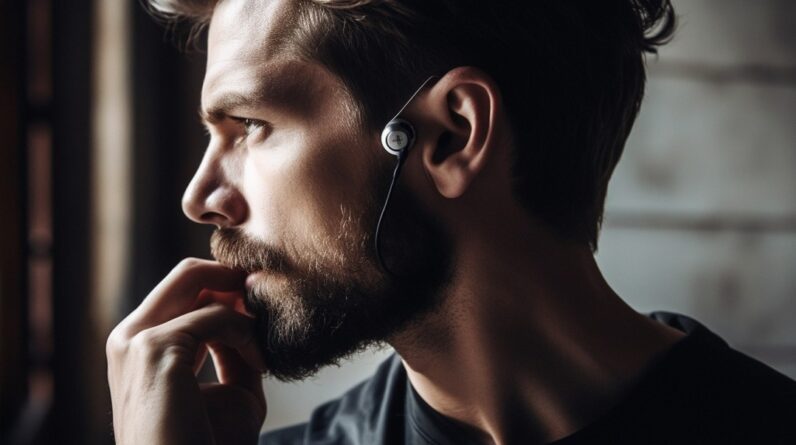
We may earn money or products from the companies mentioned in this post.
As an Amazon Associate I earn from qualifying purchases.
Introduction
You’ve probably experienced it someday, that annoying, persistent noise in your ear. No external cause, no rational explanation, just the relentless whisper, buzz, or hum. For some, it’s occasional. For others, it’s a tormenting constant. It’s known as tinnitus and can come with various manifestations. One prominent example is auricle tinnitus, an intriguing and often mystifying condition.
But what exactly is auricle tinnitus? Simply put, it’s tinnitus that appears to emanate from the auricle or outer part of the ear, and can seem deceptively like an external noise. The phantom nature of this noise can make it a challenge to diagnose and treat but fret not, understanding is the first step!
The Etiology Behind Auricle Tinnitus
The question buzzing in your head might be, what causes this seemingly mysterious auricle tinnitus? Well, like its many siblings in the tinnitus family, it can be traced back to a multitude of triggers. These range from minor incidences like exposure to loud noise or ear infections to more significant events like a head injury or certain neurological disorders.
Surprising to some, even lifestyle choices could act as a trigger. Take, for instance, your posture. Have you ever wondered can a chiropractor help with tinnitus? Misalignment in the cervical spine could feasibly contribute to tinnitus, and chiropractic adjustment might be beneficial.
But that’s not all. An individual might also develop auricle tinnitus following a traumatic brain injury. That harmless bump on the head at the soccer match might not be so harmless after all. It could evolve into tinnitus from a head injury—a direct way to auricle tinnitus.
Symptoms and Diagnosis of Auricle Tinnitus
Next, we dive into the tell-tale signs of auricle tinnitus. Notably, the primary symptom is the incessant noise–be it buzzing, ringing, or humming–from one or both ears. However, that’s not all. Some patients report dizzy spells, trouble focusing, or even feelings of fullness in the ear.
So, how is auricle tinnitus diagnosed? Through a thorough examination and an in-depth discussion of your symptoms. But rest assured, there are measures available for assessing the severity of tinnitus. The tinnitus assessment is a valuable tool used by healthcare professionals to gauge the impact of tinnitus on one’s quality of life.
Also, you might consider reading the Consumer Handbook on Tinnitus (book) for more insights into understanding your condition. This book has a heap of great advice and is helpful for those journeying through the world of tinnitus.
Alright, now we’re acquainted with auricle tinnitus, its causes, and how it’s diagnosed. But hold on, we’re far from done. Life with tinnitus can be challenging, but knowing your triggers and understanding your condition paves the way to proper treatment and management. So, stay tuned as we delve a little bit deeper into the world of tinnitus.
The Effect of Tinnitus on Everyday Life
Ever held a seashell to your ear to hear the “ocean,” only for that sound to morph into a relentlessly persistent noise refusing to leave? Tinnitus can be frustratingly similar, and our daily lives are the beaches where it crashes. It can affect sleep, concentration, and even our emotional well-being.
If you’ve ever completed a tinnitus handicap inventory, you’ll appreciate how impactful tinnitus can be. It can orchestrate our lives, set our pace, and dictate our mood, its impertinent ringing makes even simple tasks seem overwhelming.
Reviewing Popular Therapeutic Interventions
But, fear not! Hope is not lost. A broad spectrum of interventions has developed to manage tinnitus. From holistic therapies, and medications to surgical options, the path to silence is never a solitary one.
Physiotherapy, for example, holds substantial potential in managing tinnitus, particularly if your tinnitus is postural. Even more innovative approaches, like tinnitus patches, are in the works. If you’re curious, dive into our tinnitus patch review.
Looking for more options? You might consider exploring nutritional supplements for tinnitus. For a deeper dive, check out our phytate labs tinnitus reviews offering a detailed appraisal of such products.
The Role of Assistive Devices in Managing Tinnitus
If you’ve come this far, you already understand that tinnitus is complicated. Right? But wait, what about using gadgets? Could they help? Spoiler alert: Yes, they absolutely can!
Enter, noise-cancelling headphones. These aren’t just a go-to for music lovers. For some, they can offer a lifeline. Alleviating the tinnitus circus, they can keep the cacophony at bay. Dive into our guide on tinnitus headphones to know more.
Could you instead go for tinnitus noise-canceling headphones? Absolutely! Or you might be wondering, will noise-cancelling headphones help tinnitus? In some cases, they could!
Everything said, remember that managing tinnitus is a journey, not a destination. Each step, each stumble, each discovery gets us closer to that sweet, coveted silence. As with any health issue, don’t hesitate to seek professional assistance. The American Tinnitus Association is an excellent place for support and advice.
So, we’ve navigated the world of auricle tinnitus together. Now, it’s time for us to delve further into the relationship between the many hues of tinnitus and the symphony of frequencies in the world around us. Ready to dive deeper? Let’s go!
The Relationship between Tinnitus and Different Frequencies of Noise
If you’ve ever tuned a guitar or balanced a stereo, you know frequencies can be finicky. With tinnitus, it can be a similar story, with different frequencies causing different reactions.
For some, their tinnitus might mimic the hum of a refrigerator or the drone of a bee, common in low-frequency tinnitus. Alternatively, the sound might be a higher frequency, a shrill squeal, or a piercing beep. Then, there is the world of color noises. Imagine, noises having colors from best color noise for tinnitus to violet noise tinnitus, tinnitus can paint a vivid, albeit noisy, picture.
Consumer Perspectives on Auricle Tinnitus
Understanding a condition isn’t complete without considering the viewpoints of those living with it. For a more personal insight into auricle tinnitus, let’s explore some neosensory tinnitus reviews. Here, those navigating the tinnitus landscape share their experiences, challenges, and triumphs.
And it doesn’t stop there. Our blog post on the consumer handbook on tinnitus offers further insights into managing auricle tinnitus from a user perspective.
Conclusion
So what have we discovered on our journey through the land of auricle tinnitus? Firstly, it’s a complex condition with a variety of triggers and symptoms. Secondly, numerous strategies, from assistive devices to therapeutic interventions, can help manage the condition.
Beyond these current strategies, research continues to forge ahead, with promising new treatments on the horizon like oto 313 tinnitus. There’s also exciting work happening in the field of hair cell regeneration for tinnitus.
In the vast echoing cavern of tinnitus, it is easy to feel alone. But remember, numerous organizations, such as the Tinnitus Research Initiative, are stepping up with support and resources. No matter where you are on your journey, there is help, hope, and a community waiting for you. After all, the journey of a thousand miles begins with a single step towards understanding auricle tinnitus.
Auricle Tinnitus - Frequently Asked Questions (FAQ)
Auricle tinnitus is a specific type of tinnitus where the noise appears to come from the outer part of the ear, or auricle. Like other forms of tinnitus, it is characterised by the perception of sound when there’s no actual external noise.
The causes of auricle tinnitus can vary widely, and in many cases, there may be multiple contributing factors. Some common factors include exposure to loud noise, ear infections, head and neck injuries, certain types of medications, and various health conditions including high blood pressure and diabetes.
Auricle Tinnitus is diagnosed through a comprehensive examination including medical history and a careful review of symptoms. Audiometric testing may be performed as well as tinnitus assessment to measure impact on one’s quality of life. Further examinations may be needed to rule out any underlying conditions.
There are numerous strategies that can help manage auricle tinnitus. From physiotherapy, nutritional supplements, noise-cancelling headphones to therapeutic interventions like tinnitus patches. Also, look into adopting healthy lifestyle habits, such as reducing exposure to loud noise, managing stress, stopping smoking, and maintaining good cardiovascular health.
The prognosis and treatment for auricle tinnitus largely depend on the underlying cause. In many cases, the condition itself cannot be cured, but the symptoms can be effectively managed. Therapies and strategies for managing tinnitus continue to evolve, and noteworthy developments like hair cell regeneration offer hope for future treatments.
Amazon and the Amazon logo are trademarks of Amazon.com, Inc, or its affiliates.
Related posts:
- Unlocking the Secrets of Ear Pain and Ringing: Comprehensive Guide to Causes, Symptoms, and Breakthrough Relief Strategies
- Understanding ADHD and Tinnitus: Is there a Connection?
- Antibiotics and Tinnitus: The Hidden Link and How to Protect Your Hearing
- Beyond the Ringing: The Unexpected Connection Between OCD and Tinnitus









1 Comment